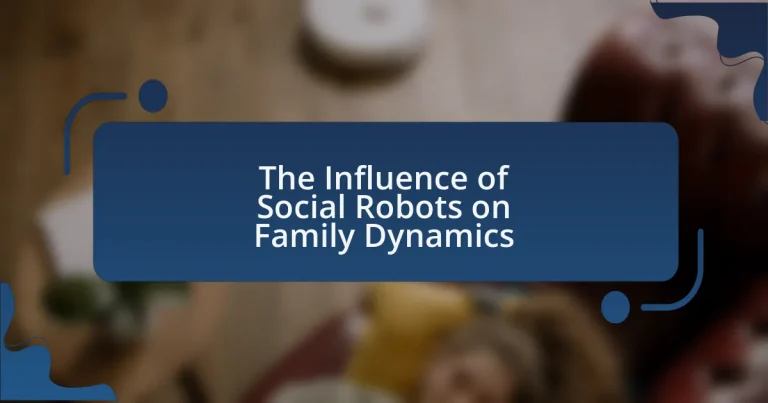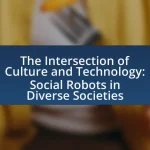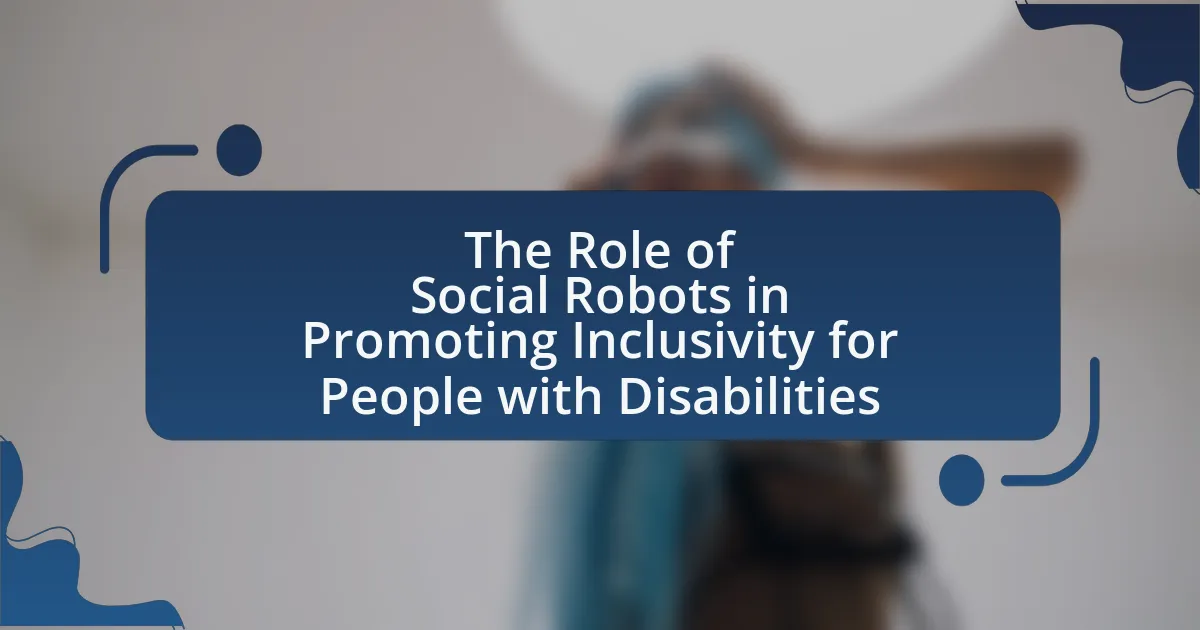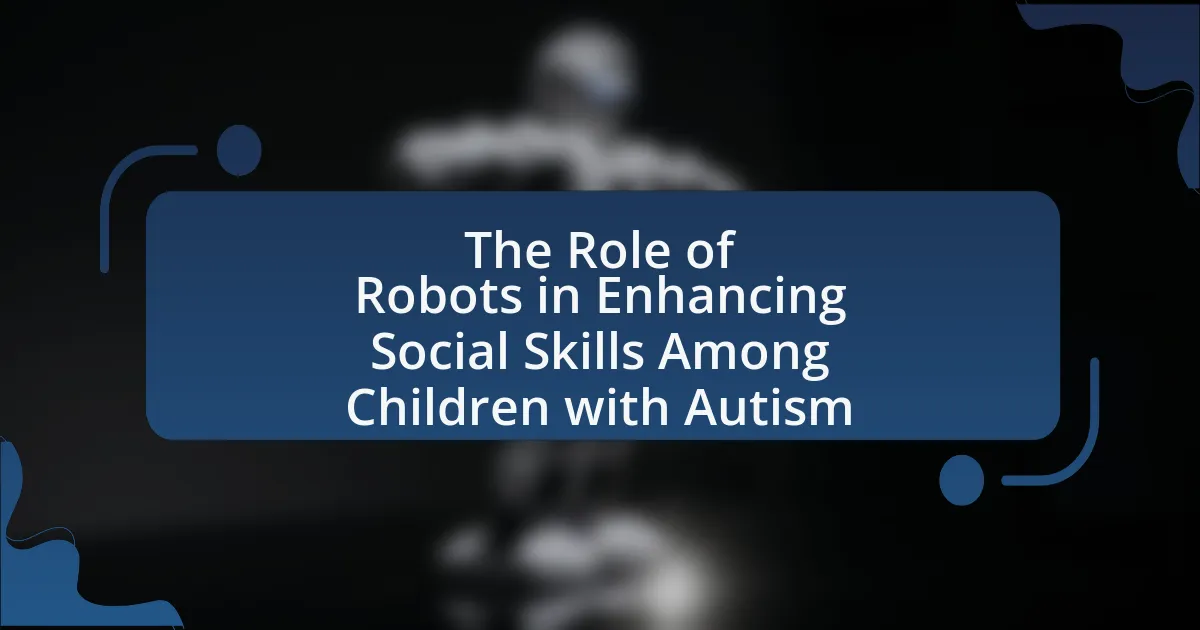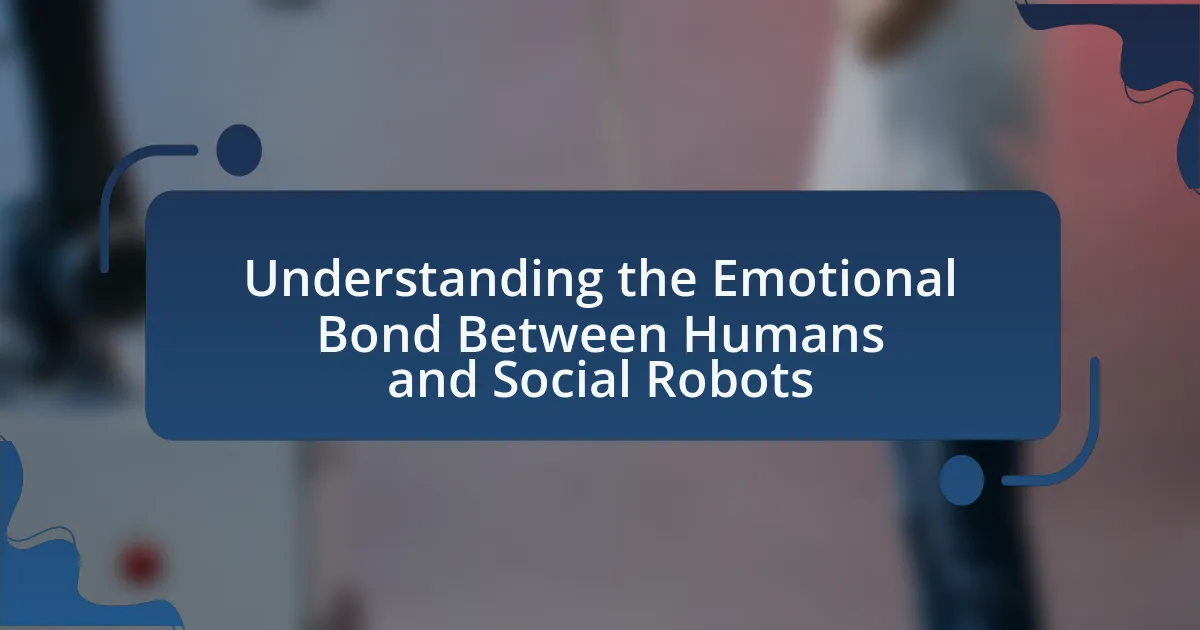Social robots are increasingly influencing family dynamics by enhancing communication, providing companionship, and assisting with caregiving tasks. Research shows that their integration into family life leads to improved interactions, emotional connections, and support, particularly for elderly members and children. Social robots serve various roles, including educational support and household assistance, which can alleviate loneliness and foster stronger emotional bonds among family members. However, challenges such as privacy concerns and the potential for reduced human interaction must be addressed to ensure a positive impact on family relationships. The article explores these aspects, highlighting the benefits, perceptions, and ethical considerations surrounding the use of social robots in family settings.
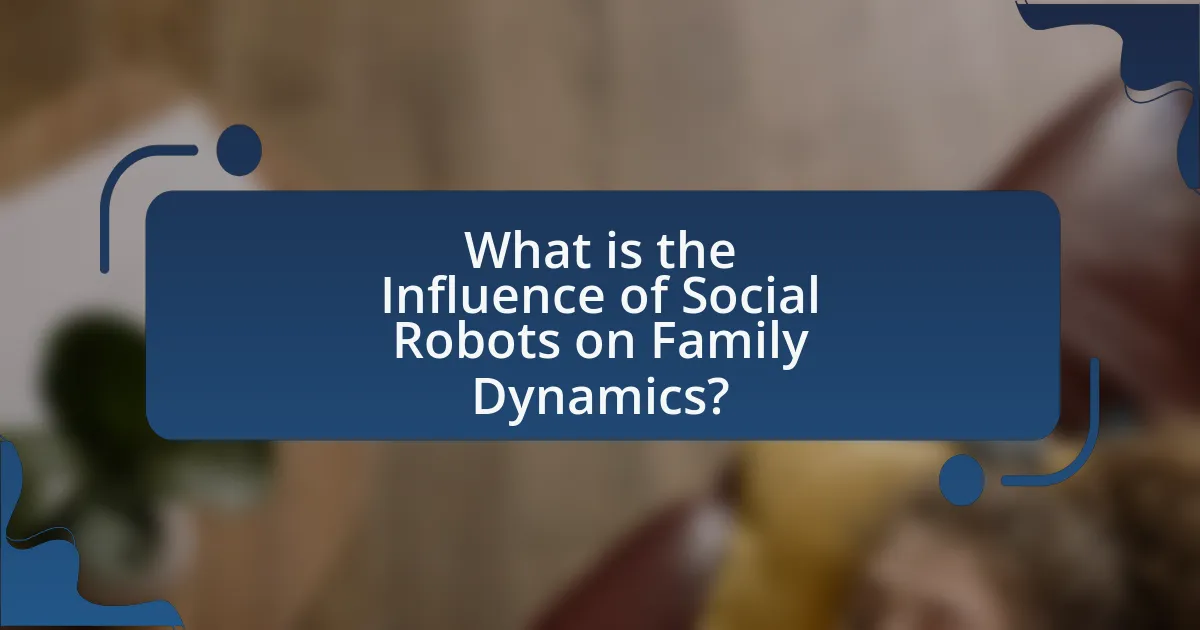
What is the Influence of Social Robots on Family Dynamics?
Social robots significantly influence family dynamics by enhancing communication, providing companionship, and assisting with caregiving tasks. Research indicates that families using social robots experience improved interactions, as these robots can facilitate conversations and reduce feelings of loneliness among family members. For instance, a study published in the journal “Robotics and Autonomous Systems” by K. Dautenhahn et al. (2018) found that social robots can foster emotional connections and support family cohesion, particularly in households with elderly members or children. This integration of social robots into family life can lead to more engaged relationships and a supportive environment, ultimately reshaping traditional family roles and interactions.
How do social robots integrate into family life?
Social robots integrate into family life by serving as companions, educators, and assistants, enhancing interaction and engagement among family members. These robots can facilitate communication, especially in families with children or elderly members, by providing reminders, entertainment, and educational support. For instance, studies have shown that robots like NAO and Pepper can improve social skills in children with autism by encouraging interaction and play. Additionally, social robots can help manage household tasks, such as scheduling and reminders, thereby reducing stress and improving family organization. The presence of social robots has been linked to increased emotional bonding and support within families, as they often provide a non-judgmental presence that encourages open communication.
What roles do social robots play in daily family interactions?
Social robots serve multiple roles in daily family interactions, including companionship, educational support, and assistance with household tasks. These robots can engage family members in conversation, provide emotional support, and help alleviate feelings of loneliness, particularly among elderly family members. Research indicates that social robots can enhance learning experiences for children by providing interactive educational content, thereby fostering cognitive development. Additionally, they can assist with routine chores, such as reminders for medication or scheduling, which helps streamline family responsibilities. Studies have shown that families who integrate social robots into their daily lives report improved communication and stronger emotional bonds, highlighting their positive impact on family dynamics.
How do family members perceive the presence of social robots?
Family members generally perceive the presence of social robots as beneficial, viewing them as companions that can enhance social interaction and support daily activities. Research indicates that family members appreciate social robots for their ability to assist with tasks, provide emotional support, and facilitate communication among family members. For instance, a study published in the journal “Robotics and Autonomous Systems” by authors K. K. K. Lee and M. A. A. Alavi found that families reported increased feelings of companionship and reduced loneliness when integrating social robots into their home environment. This positive perception is often influenced by the robot’s design, functionality, and the specific needs of the family, leading to a generally favorable attitude towards their presence.
What are the potential benefits of social robots for families?
Social robots can enhance family dynamics by providing companionship, educational support, and assistance with daily tasks. These robots can engage children in learning activities, fostering cognitive development and social skills. For instance, studies have shown that children interacting with social robots exhibit improved language skills and emotional understanding. Additionally, social robots can alleviate loneliness among elderly family members by offering social interaction and reminders for medication or appointments, thus promoting overall well-being. Research indicates that families using social robots report increased communication and bonding, as these devices can facilitate shared activities and discussions.
How can social robots enhance communication among family members?
Social robots can enhance communication among family members by facilitating interactions and providing a platform for shared activities. These robots can engage users in conversations, assist with reminders, and encourage collaborative tasks, thereby promoting dialogue and connection. Research indicates that families using social robots report improved communication dynamics, as these devices can help bridge generational gaps and provide a non-judgmental space for expression. For instance, a study published in the journal “Human-Computer Interaction” by authors K. K. Lee and M. A. K. H. Wong found that families interacting with social robots experienced increased emotional bonding and reduced communication barriers, highlighting their effectiveness in enhancing familial relationships.
What emotional support can social robots provide to families?
Social robots can provide emotional support to families by offering companionship, reducing feelings of loneliness, and facilitating communication among family members. These robots are designed to engage users through conversation, interactive activities, and emotional recognition, which can enhance the emotional well-being of individuals, particularly the elderly and children. Research has shown that social robots can effectively reduce anxiety and depression levels in users, as evidenced by a study published in the journal “Frontiers in Psychology,” which found that interactions with social robots led to significant improvements in emotional states among participants. Additionally, social robots can help bridge communication gaps in families, especially in cases where members may struggle to express their feelings, thereby fostering a more supportive family environment.
What challenges do families face with the introduction of social robots?
Families face several challenges with the introduction of social robots, including concerns about privacy, emotional attachment, and the potential for reduced human interaction. Privacy issues arise as families may worry about data collection and surveillance capabilities of social robots, which can lead to distrust. Emotional attachment can develop, particularly in children, leading to complications in relationships with human family members. Additionally, reliance on social robots for companionship or assistance may diminish face-to-face interactions, impacting family dynamics and communication. These challenges highlight the need for careful consideration and management of social robot integration into family life.
How do social robots affect traditional family roles?
Social robots significantly alter traditional family roles by introducing new dynamics in caregiving, companionship, and household responsibilities. For instance, studies have shown that social robots can assist with elderly care, allowing family members to balance work and caregiving more effectively, thereby shifting the traditional caregiver role from solely human to include robotic assistance. Research published in the journal “Robotics and Autonomous Systems” indicates that families using social robots report improved emotional well-being and reduced stress, as robots can provide companionship and support, which traditionally fell on family members. This integration of robots into family life can lead to a redefinition of roles, where technology complements human interaction rather than replacing it.
What concerns do families have regarding privacy and security with social robots?
Families have significant concerns regarding privacy and security with social robots, primarily related to data collection and surveillance. Social robots often gather personal information, including conversations and interactions, which raises fears about unauthorized access and misuse of sensitive data. A study by the University of Cambridge found that 60% of parents expressed worries about their children’s data being collected by smart devices, highlighting the prevalent anxiety surrounding privacy. Additionally, families are concerned about the potential for hacking, which could lead to breaches of security and exposure of personal information. These concerns reflect a broader apprehension about the implications of integrating social robots into daily life, particularly in family settings.
How do social robots influence children’s development within families?
Social robots influence children’s development within families by enhancing social interaction, emotional learning, and cognitive skills. Research indicates that children who interact with social robots exhibit improved communication abilities and emotional understanding. For instance, a study published in the journal “Interaction Studies” by Kory and Breazeal (2014) found that children who engaged with a social robot demonstrated increased empathy and social skills compared to those who did not. Additionally, social robots can serve as educational tools, promoting problem-solving and critical thinking through interactive play. This multifaceted influence contributes to a child’s overall development within the family context.
What impact do social robots have on children’s social skills?
Social robots positively impact children’s social skills by enhancing their ability to interact and communicate effectively. Research indicates that children who engage with social robots demonstrate improved empathy, turn-taking, and emotional recognition. For instance, a study published in the journal “Interaction Studies” by Kory and Breazeal (2014) found that children who interacted with a social robot showed increased prosocial behaviors and better understanding of social cues compared to those who did not. This evidence supports the notion that social robots can serve as valuable tools in developing essential social competencies in children.
How do children interact with social robots compared to human family members?
Children interact with social robots differently than with human family members, often displaying more openness and less social anxiety with robots. Research indicates that children may engage in more imaginative play and express emotions more freely when interacting with social robots, as these robots can provide consistent responses and non-judgmental engagement. For example, a study by Kory and Breazeal (2014) found that children were more likely to share personal stories and feelings with a robot than with a human, highlighting the unique role robots can play in facilitating communication and emotional expression. This suggests that social robots can serve as effective tools for enhancing children’s social skills and emotional development within family dynamics.
What ethical considerations arise from the use of social robots in family settings?
The ethical considerations arising from the use of social robots in family settings include issues of privacy, emotional attachment, and dependency. Privacy concerns stem from the data collection capabilities of social robots, which can record personal interactions and family dynamics, potentially leading to unauthorized surveillance or data misuse. Emotional attachment is another significant consideration, as family members, particularly children and the elderly, may develop strong bonds with robots, raising questions about the authenticity of relationships and the potential for emotional manipulation. Dependency on social robots for companionship or caregiving can also create ethical dilemmas, as it may undermine human interactions and responsibilities within the family unit. These considerations highlight the need for careful evaluation of the implications of integrating social robots into family life.
How do social robots challenge concepts of companionship and care?
Social robots challenge concepts of companionship and care by introducing artificial entities that can simulate emotional connections and caregiving roles traditionally fulfilled by humans. These robots, such as Paro and Jibo, are designed to provide companionship and support, particularly for the elderly or those with social isolation, thereby blurring the lines between human and machine interactions. Research indicates that interactions with social robots can evoke emotional responses similar to those experienced in human relationships, as evidenced by studies showing increased feelings of happiness and reduced loneliness among users. This shift raises ethical questions about the authenticity of relationships formed with robots and the potential impact on human caregiving roles, as reliance on robots for companionship may alter family dynamics and social structures.
What guidelines should families follow when integrating social robots?
Families should follow guidelines that emphasize clear communication, setting boundaries, and monitoring interactions when integrating social robots. Clear communication ensures that all family members understand the purpose and capabilities of the robot, which can enhance acceptance and reduce misunderstandings. Setting boundaries involves defining appropriate usage times and contexts for the robot, helping to maintain a balance between technology and family interactions. Monitoring interactions is crucial to ensure that the robot’s influence remains positive and that it does not replace essential human connections. Research indicates that families who actively engage with social robots while maintaining these guidelines report improved family dynamics and enhanced emotional well-being.
How can families effectively incorporate social robots into their dynamics?
Families can effectively incorporate social robots into their dynamics by establishing clear roles for the robots that complement family activities and enhance communication. For instance, social robots can serve as educational tools, providing interactive learning experiences for children, which has been shown to improve engagement and retention of information. Research indicates that children who interact with educational robots demonstrate higher levels of motivation and learning outcomes compared to traditional methods. Additionally, families can use social robots to facilitate family bonding activities, such as games or storytelling, which can strengthen relationships and create shared experiences. By integrating social robots into daily routines, families can foster a supportive environment that encourages collaboration and emotional connection.
What best practices should families adopt for using social robots?
Families should adopt best practices such as setting clear boundaries, encouraging human interaction, and monitoring usage when using social robots. Establishing boundaries helps prevent over-reliance on robots for companionship, ensuring that family members engage with each other. Encouraging human interaction fosters emotional connections and social skills, which are essential for healthy family dynamics. Monitoring usage allows families to assess the impact of social robots on relationships and adjust their integration accordingly. Research indicates that balanced use of technology, including social robots, can enhance family communication and cohesion when managed properly.
How can families evaluate the effectiveness of social robots in their home?
Families can evaluate the effectiveness of social robots in their home by assessing their impact on communication, emotional support, and daily task assistance. To do this, families can track changes in interactions among family members, noting improvements in communication or emotional well-being attributed to the robot’s presence. Research indicates that social robots can enhance social engagement and reduce feelings of loneliness, particularly among elderly family members, which can be measured through surveys or observational studies. Additionally, families can monitor the robot’s ability to assist with daily tasks, such as reminders for medication or scheduling, and evaluate how these functionalities contribute to overall household efficiency. By collecting qualitative and quantitative data on these aspects, families can form a comprehensive understanding of the robot’s effectiveness in their home environment.
